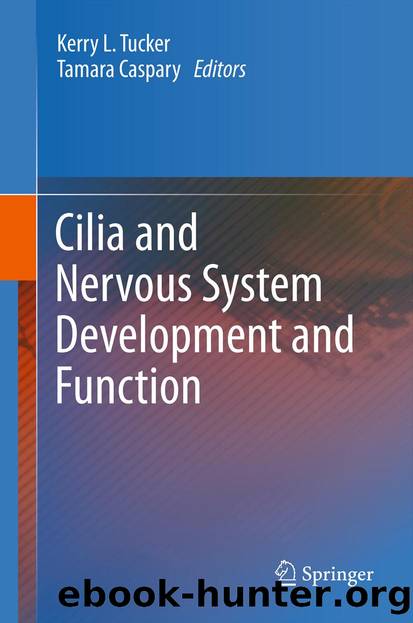Cilia and Nervous System Development and Function by Kerry L. Tucker & Tamara Caspary

Author:Kerry L. Tucker & Tamara Caspary
Language: eng
Format: epub
Publisher: Springer Netherlands, Dordrecht
5.5.1 The Development of the Hair Bundle
In the mouse, formation of cochlear sensory hair cells begins around embryonic day (E) 12-E14, when precursors for the organ of Corti exit the cell cycle and commit to either a hair cell or supporting cell fate (Chen et al. 2002; Ruben 1967). Hair cell differentiation then initiates in the basal region of the cochlea between E13.5 and E14.5 and over the next 3 days, hair cell differentiation proceeds in a basal to apical gradient along the entire length of the sensory epithelium, until one row of inner and three rows of outer hair cells are formed (McKenzie et al. 2004). In addition, a second gradient of differentiation moves across the medial to lateral axis of the epithelium, such that the inner hair cells appear first followed by each row of outer hair cells (Chen et al. 2002; McKenzie et al. 2004). In the vestibular organs, hair cell differentiation begins slightly earlier, at around E12.
During the early stages of hair cell differentiation, development of the hair bundle occurs (Fig. 5.3). At the start of bundle development, the hair cell apical surface is covered by very short microvilli of uniform height and a single kinocilium rests at its center. Then by around E13.5 in the vestibular organs and E15.5 in the cochlea, a few, very short precursor microvilli that will eventually give rise to stereocilia grow up around the kinocilium. Next, by around E15.5 in the vestibular organs and E16.5 in the cochlea, the kinocilium moves from the center of the luminal surface of the hair cell to the peripheral edge (Cotanche and Corwin 1991; Dabdoub and Kelley 2005). Simultaneously, the precursor microvilli immediately surrounding the developing kinocilium begin to elongate to form stereocilia, followed by the elongation of those stereocilia in rows further away from the kinocilium, initiating the staircase pattern of height ranked rows. Thus, development of the kinocilium appears to precede that of the stereocilia, and it is easy to speculate from its positioning in the bundle that it somehow helps to direct the pattern of stereocilia elongation (and the formation of the V-shaped bundle structure in the cochlea). Furthermore, the polarization of the kinocilium also precedes that of the stereocilia and parallels the PCP axis of the epithelium, suggesting that the kinocilium is a major determinant of hair cell planar orientation.
Interestingly, although the initial movement of the kinocilium to the peripheral edge of the hair cell has a significant bias in the direction of final orientation of the bundle (towards the lateral edge), the resulting position often deviates from its final position. Therefore, the kinocilium (and adjacent stereocilia) often undergo a period of reorientation in order to become fully aligned with their neighbors (Cotanche and Corwin 1991; Dabdoub and Kelley 2005). Following this reorientation period, the newly formed stereocilia continue to grow in width and also form rootlets that will anchor them into the cuticular plate. By the end of embryogenesis, most nascent hair bundles in the cochlea exhibit their characteristic
Download
This site does not store any files on its server. We only index and link to content provided by other sites. Please contact the content providers to delete copyright contents if any and email us, we'll remove relevant links or contents immediately.
| Automotive | Engineering |
| Transportation |
Whiskies Galore by Ian Buxton(41879)
Introduction to Aircraft Design (Cambridge Aerospace Series) by John P. Fielding(33064)
Small Unmanned Fixed-wing Aircraft Design by Andrew J. Keane Andras Sobester James P. Scanlan & András Sóbester & James P. Scanlan(32743)
Craft Beer for the Homebrewer by Michael Agnew(18140)
Turbulence by E. J. Noyes(7936)
The Complete Stick Figure Physics Tutorials by Allen Sarah(7307)
Kaplan MCAT General Chemistry Review by Kaplan(6866)
The Thirst by Nesbo Jo(6826)
Bad Blood by John Carreyrou(6552)
Modelling of Convective Heat and Mass Transfer in Rotating Flows by Igor V. Shevchuk(6391)
Learning SQL by Alan Beaulieu(6209)
Weapons of Math Destruction by Cathy O'Neil(6142)
Man-made Catastrophes and Risk Information Concealment by Dmitry Chernov & Didier Sornette(5921)
Digital Minimalism by Cal Newport;(5663)
Life 3.0: Being Human in the Age of Artificial Intelligence by Tegmark Max(5474)
iGen by Jean M. Twenge(5366)
Secrets of Antigravity Propulsion: Tesla, UFOs, and Classified Aerospace Technology by Ph.D. Paul A. Laviolette(5309)
Design of Trajectory Optimization Approach for Space Maneuver Vehicle Skip Entry Problems by Runqi Chai & Al Savvaris & Antonios Tsourdos & Senchun Chai(5011)
Pale Blue Dot by Carl Sagan(4912)
